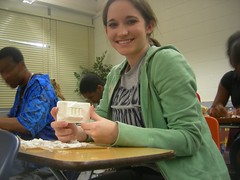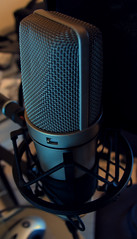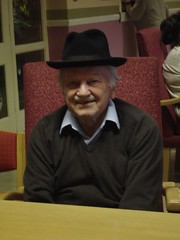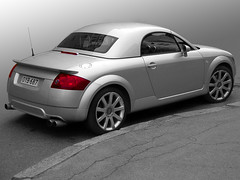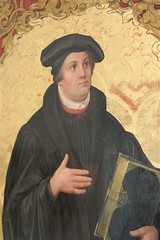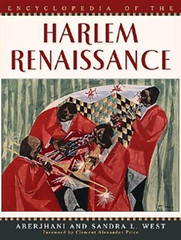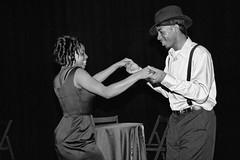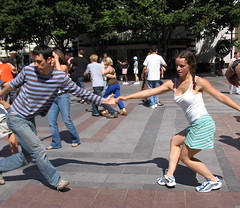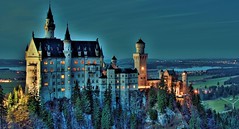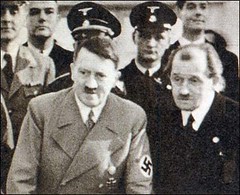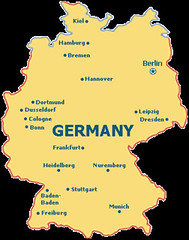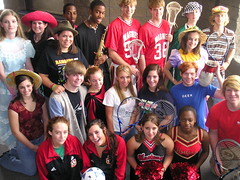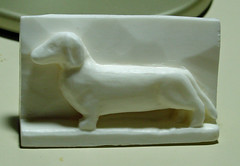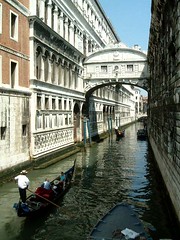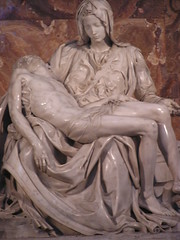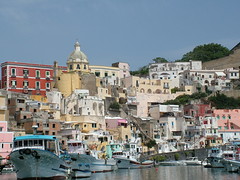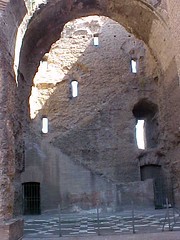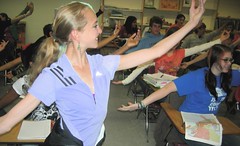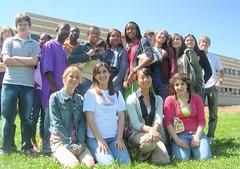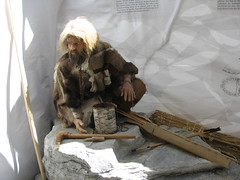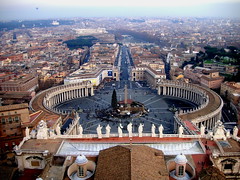Both notable scientists, Von Braun was a Nazi rocket scientist - developer of the amazing and deadly V2 - who was asked to be part of the US rocket team after WWII. He became a valued American scientist.
He became a naturalized U.S. citizen and worked on the American ICBM program before joining NASA, where he served as director of NASA's Marshall Space Flight Center and was the chief architect of the Saturn V launch vehicle, the superbooster that propelled the United States to the Moon.
Monday, April 30, 2007
Nazi German conquests and defeats in WWII
Nazi victories in the blitzkreig (lightening war):
1. Austria (the Von Trapp family escapes)
2. Czechoslovakia
3. Poland - 1939
4. Norway
5. Battle of Britain: some 6 months of bombing British cities resulted in awesome devastation but did not produce a victory. The Brits held tight under their Prime Minister, Winston Churchill. Hitler decided to invade Russia instead of continuing the attack against England.
6. While the German army killed millions of Russians, they never could declare a victory over the Ruskies. By 1944 the Russian army had recovered enough to attack the Germans and help the British and American defeat of the Nazis.
7. Netherland & Belgium were, like the eastern neighbors, easily defeated by the Nazis.
8. France was also quickly defeated and occupied by the Germans. Many Frenchmen fought the germans by sabotage and other underground efforts.
HItler's strategic mistakes:
a) Not continuing the Battle of Britain.
b) Not being more mindful of his attack on Russia.
c) Not securing the petroleum supplies of Rissia or the Mid East. He sent one of his best generals, Rommel, to North Africa to conquer the Mid East. Rommel was defeated by the British and US forces.
1. Austria (the Von Trapp family escapes)
2. Czechoslovakia
3. Poland - 1939
4. Norway
5. Battle of Britain: some 6 months of bombing British cities resulted in awesome devastation but did not produce a victory. The Brits held tight under their Prime Minister, Winston Churchill. Hitler decided to invade Russia instead of continuing the attack against England.
6. While the German army killed millions of Russians, they never could declare a victory over the Ruskies. By 1944 the Russian army had recovered enough to attack the Germans and help the British and American defeat of the Nazis.
7. Netherland & Belgium were, like the eastern neighbors, easily defeated by the Nazis.
8. France was also quickly defeated and occupied by the Germans. Many Frenchmen fought the germans by sabotage and other underground efforts.
HItler's strategic mistakes:
a) Not continuing the Battle of Britain.
b) Not being more mindful of his attack on Russia.
c) Not securing the petroleum supplies of Rissia or the Mid East. He sent one of his best generals, Rommel, to North Africa to conquer the Mid East. Rommel was defeated by the British and US forces.
Jewish resistance to the Nazis: Albert Einstein, etc
Some Jews left Germany in the early 1930's. One example was scientist Albert Einstein.
From 1935 to 1938 Jews could leave only if they took nothing with them. They would forfeit their possessions, property, and cash, says World Book.
Neighboring nations closed their borders to Jewish migration. It's a sad fact that the US tightened its restrictions against Jewish immigration during the late 1930's and 1940s.
Why didn't Jews fight back against the Nazis?
a) Jews were accustomed to periodic persecution over their long history in Europe. Their survival strategy was to adopt a low profile and get through by bribery and accomodation.
b) Jews may have counted on escape routes that did not materialize.
c) Ordinarily Jewish wisdom was not to fight physically but to escape or use their imagination. In the case of the Warsaw ghetto ( the story is told in the recommendable movie Schindler's List) the Jews were prepared to fight the Nazis. But the Jews did not have a chance of victory.
How did people of conscience react to the advent of Hitler's Nazi Reich?
- Protest? Hitler brutally and effectively suppressed protest.
- Defiance? There was little defiance.
- Quiet cooperation while waiting for a better time? Yes.
From the movie Swing Kids: "You've got to go along; make the best of things."
Some Germans attempted to hide some of their Jewish neighbors from the Nazis. The Dutch friends of the Frank family in Amsterdam hid a group of Jews. The Frank group was discovered and betrayed by outsiders. All the family but Otto, the father, perished in death camps.
From 1935 to 1938 Jews could leave only if they took nothing with them. They would forfeit their possessions, property, and cash, says World Book.
Neighboring nations closed their borders to Jewish migration. It's a sad fact that the US tightened its restrictions against Jewish immigration during the late 1930's and 1940s.
Why didn't Jews fight back against the Nazis?
a) Jews were accustomed to periodic persecution over their long history in Europe. Their survival strategy was to adopt a low profile and get through by bribery and accomodation.
b) Jews may have counted on escape routes that did not materialize.
c) Ordinarily Jewish wisdom was not to fight physically but to escape or use their imagination. In the case of the Warsaw ghetto ( the story is told in the recommendable movie Schindler's List) the Jews were prepared to fight the Nazis. But the Jews did not have a chance of victory.
How did people of conscience react to the advent of Hitler's Nazi Reich?
- Protest? Hitler brutally and effectively suppressed protest.
- Defiance? There was little defiance.
- Quiet cooperation while waiting for a better time? Yes.
From the movie Swing Kids: "You've got to go along; make the best of things."
Some Germans attempted to hide some of their Jewish neighbors from the Nazis. The Dutch friends of the Frank family in Amsterdam hid a group of Jews. The Frank group was discovered and betrayed by outsiders. All the family but Otto, the father, perished in death camps.
Deutschland: map quiz Tues, May 1
Map quiz . . .
1. Ten neighboring nations and bodies of water.
2. 3 cities in Germany.
3. Borders.
15 pts total.
1. Ten neighboring nations and bodies of water.
2. 3 cities in Germany.
3. Borders.
15 pts total.
Friday, April 27, 2007
Mason Nabors
Learning the concept of relief through relief sculpture in soap was a challenge for most students. After all, it was a first attempt for nearly everyone. But top art students such as Mason nabors proved their talent with the soap.
Thursday, April 26, 2007
Noah Wylie played Emil, the tough Hitler Jugend, in Swing Kids
Swing Kids review / Trudeau
1. This movie is set in the city of a) Hamburg b) Munich c) Berlin.
2. The movie takes place 9 years after Hitler took power, or a) 1936 b) 1939 c) 1941.
3. The American music and slang treasured by the swing kids originates mostly in
a) Brooklyn b) Harlem c) the Bronx d) Lower East Side.
4. German swing kids favor a clothing style reflective of __ style. a) American
b) British c) Dutch d) German.
5. The new style of 1930’s jazz groups was a) small combo b) big bands
c) electric guitars, bass and organ.
6. Hitler’s regime is referred to as the a) Reign b) Reich c) Rotterdam.
7. German authorities have banned American __ if they were created by Negroes or Jews. a) books b) records c) art.
8. Peter Muller has lost his father through Nazi imprisonment. Was the father Jewish? Y / N
9. The physician father of Thomas Berger is taken away by authorities due to of his son’s participation in the a) jazz club b) Hitler Youth c) university.
10. Arvid is a jazz guitarist who reminds of the famous Belgian gypsy guitar player named a) Stephane Grapelli b) Peter Frampton c) Django Reinhardt.
11. Peter Muller is disappointed in his mother for her attitude toward the Nazi authorities. her attitude is one of a) defiance b) compliance c) despair.
12. The smooth, seemingly helpful Herr Knopp is a member of the Nazi secret police, or the a) Panzers b) Blitzkrieg c) Gestapo.
13. Peter works as a delivery boy for Herr Schumler. “Herr” means a) store owner b) Mr. c) Professor.
14. In the jazz world a blindfold quiz is one in which you must name the
a) musicians b) type of jazz c) rating earned by the record.
15. Jazz was born in the city of a) Chicago b) New Orleans c) NYC.
16. Name a jazz composer and pianist: a) Duke Ellington b) Louis Armstrong
c) Antonio Vivaldi.
17. Exercise and athletic competition in the German mountainside as well as bonuses like a motorbike were strategies used by the a) universities b) Hitler Youth c) jazz club owners.
18. The Nazis were effective at building a type of super-patriotism. To convince the youth of the Nazi point of view they used exaggeration and fabrications. This is called a) propaganda b) advertising c) nationalism d) enthusiasm.
19. The National Socialist German Worker’s Party was not at all a) socialist
b) German c) national.
20. Hitler demanded a cheap auto design from a) Mercedes b) Porsche c) Audi.
1. This movie is set in the city of a) Hamburg b) Munich c) Berlin.
2. The movie takes place 9 years after Hitler took power, or a) 1936 b) 1939 c) 1941.
3. The American music and slang treasured by the swing kids originates mostly in
a) Brooklyn b) Harlem c) the Bronx d) Lower East Side.
4. German swing kids favor a clothing style reflective of __ style. a) American
b) British c) Dutch d) German.
5. The new style of 1930’s jazz groups was a) small combo b) big bands
c) electric guitars, bass and organ.
6. Hitler’s regime is referred to as the a) Reign b) Reich c) Rotterdam.
7. German authorities have banned American __ if they were created by Negroes or Jews. a) books b) records c) art.
8. Peter Muller has lost his father through Nazi imprisonment. Was the father Jewish? Y / N
9. The physician father of Thomas Berger is taken away by authorities due to of his son’s participation in the a) jazz club b) Hitler Youth c) university.
10. Arvid is a jazz guitarist who reminds of the famous Belgian gypsy guitar player named a) Stephane Grapelli b) Peter Frampton c) Django Reinhardt.
11. Peter Muller is disappointed in his mother for her attitude toward the Nazi authorities. her attitude is one of a) defiance b) compliance c) despair.
12. The smooth, seemingly helpful Herr Knopp is a member of the Nazi secret police, or the a) Panzers b) Blitzkrieg c) Gestapo.
13. Peter works as a delivery boy for Herr Schumler. “Herr” means a) store owner b) Mr. c) Professor.
14. In the jazz world a blindfold quiz is one in which you must name the
a) musicians b) type of jazz c) rating earned by the record.
15. Jazz was born in the city of a) Chicago b) New Orleans c) NYC.
16. Name a jazz composer and pianist: a) Duke Ellington b) Louis Armstrong
c) Antonio Vivaldi.
17. Exercise and athletic competition in the German mountainside as well as bonuses like a motorbike were strategies used by the a) universities b) Hitler Youth c) jazz club owners.
18. The Nazis were effective at building a type of super-patriotism. To convince the youth of the Nazi point of view they used exaggeration and fabrications. This is called a) propaganda b) advertising c) nationalism d) enthusiasm.
19. The National Socialist German Worker’s Party was not at all a) socialist
b) German c) national.
20. Hitler demanded a cheap auto design from a) Mercedes b) Porsche c) Audi.
Wednesday, April 25, 2007
Hands-on lesson in the difference in elevations: relief sculpture
Students were generous in bringing extra soap today. Thanks, parents for helping by sending the extras. That meant 100% of my pupils applied themselves to the task.
Monday, April 23, 2007
Hitler's rise to political power in 1930's Germany
Adolf Hitler became the Chancellor of Germany in January 1933, says Wikipedia.com. His rise to power was facilitated by President Paul von Hindenburg, the German army and many politicians. Combining the posts of president and Chancellor, he acquired supreme authority of Germany by making the Nazi party as his powerbase to rise to power.
He first established a Nazi dictatorship by means of the Enabling Act. In March 1933, to obtain two-thirds of the majority needed to enact the Enabling Act, the Nazi party used the Reichstag fire to argue that a Communist revolution was imminent and thus depower the communists. Furthermore, the Nazi policies were much more appealing relative to that of the failed Weimar Republic's and thus, large numbers turned to Hitler as they were longing for a period of stability within Germany after an unsuccessful rule by the Weimar Republic.
The Nazis came to power through an alliance with some traditional conservative factions, although they experienced opposition from the opposing parties including the spd, kpd and zentrum party. Franz von Papen, a conservative former German Chancellor and former member of the Catholic Centre Party, supported Hitler for the position of Chancellor.
Political and corporate engineering won Hitler the Chancellorship. In 1933 the Enabling Act gave Hitler dictatorial power. This Act passed with the support of the Huguenbergian German National People's Party (DNVP), a few liberals, and all conservative and centrist deputies in the constitutionally-disabled and effectively rigged Reichstag.
This remaining bloc easily defeated the sole opposition of the Social Democrats, because a large proportion of the Communists had been either arrested or murdered.
He first established a Nazi dictatorship by means of the Enabling Act. In March 1933, to obtain two-thirds of the majority needed to enact the Enabling Act, the Nazi party used the Reichstag fire to argue that a Communist revolution was imminent and thus depower the communists. Furthermore, the Nazi policies were much more appealing relative to that of the failed Weimar Republic's and thus, large numbers turned to Hitler as they were longing for a period of stability within Germany after an unsuccessful rule by the Weimar Republic.
The Nazis came to power through an alliance with some traditional conservative factions, although they experienced opposition from the opposing parties including the spd, kpd and zentrum party. Franz von Papen, a conservative former German Chancellor and former member of the Catholic Centre Party, supported Hitler for the position of Chancellor.
Political and corporate engineering won Hitler the Chancellorship. In 1933 the Enabling Act gave Hitler dictatorial power. This Act passed with the support of the Huguenbergian German National People's Party (DNVP), a few liberals, and all conservative and centrist deputies in the constitutionally-disabled and effectively rigged Reichstag.
This remaining bloc easily defeated the sole opposition of the Social Democrats, because a large proportion of the Communists had been either arrested or murdered.
Expensive but in great demand where people care about high fidelity: the Neumann U87
Neumann mics may cost $2000 to perhaps $5000, but these German instruments are considered the Rolls Royces of vocal recording.
Reminds us of German excellence in the world of music.
Reminds us of German excellence in the world of music.
Originally a German formal hat, the Homburg is a classic
A homburg is a stiff felt hat, says Wikipedia, that is superficially very similar to the fedora, since both can have a crease from the front to the back of the crown, known as a "center dent". The homburg usually has no pinches, and has a brim with the edge sharply turned up all the way around. It is typically made from wool or fur felt and has a grosgrain hatband and brim treatment with an optional feather.
It was popularized by Edward VII after he visited Germany and brought back a hat of this style.
Like the fedora, the homburg was once quite popular and is still available in almost any color, but the most common colors are black, grey, and brown.
It was popularized by Edward VII after he visited Germany and brought back a hat of this style.
Like the fedora, the homburg was once quite popular and is still available in almost any color, but the most common colors are black, grey, and brown.
Manhattan and Harlem
Not to be forgotten!
Harlem
Columbia U.
Upper West Side
Upper East Side
Metropolitan Museum of Art
UN Bldg
Times Square
Lincoln Center
Times Square
Empire State Bldg
Ground Zero (WTC site)
Harlem
Columbia U.
Upper West Side
Upper East Side
Metropolitan Museum of Art
UN Bldg
Times Square
Lincoln Center
Times Square
Empire State Bldg
Ground Zero (WTC site)
Gypsy jazz guitarist Django Reinhardt
Born in Belgium, Django Reinhardt spent most of his youth in gypsy encampments close to Paris, playing banjo, guitar and violin from an early age professionally at Bal-musette halls in Paris. He started first on the violin and eventually moved on to a banjo-guitar that had been given to him.
Jean Baptiste "Django" Reinhardt (January 23, 1910 – May 16, 1953) was a Belgian Sinti jazz guitarist, says Wikipedia. He was one of the first prominent jazz musicians to be born in Europe, and one of the most renowned jazz guitarists of all time.
In 1934, Louis Vola formed the "Quintette du Hot Club de France" with Reinhardt, violinist Stéphane Grappelli, Reinhardt's brother Joseph and Roger Chaput on guitar, and himself on bass.
The concept of "lead guitar" (Django) and backing "rhythm guitar" (Joseph Reinhardt) was born with that band. They also used their guitars for percussive sounds, as they had no true percussion section.
Reinhardt survived World War II unscathed, unlike many other Gypsies who perished in the concentration death camps of the Nazis. It was especially hard for Django's people because jazz itself was not allowed under Hitler's regime. He had the help of a Luftwaffe official named Dietrich Schulz-Köhn, also known as "Doktor Jazz", who deeply admired his music.
Jean Baptiste "Django" Reinhardt (January 23, 1910 – May 16, 1953) was a Belgian Sinti jazz guitarist, says Wikipedia. He was one of the first prominent jazz musicians to be born in Europe, and one of the most renowned jazz guitarists of all time.
In 1934, Louis Vola formed the "Quintette du Hot Club de France" with Reinhardt, violinist Stéphane Grappelli, Reinhardt's brother Joseph and Roger Chaput on guitar, and himself on bass.
The concept of "lead guitar" (Django) and backing "rhythm guitar" (Joseph Reinhardt) was born with that band. They also used their guitars for percussive sounds, as they had no true percussion section.
Reinhardt survived World War II unscathed, unlike many other Gypsies who perished in the concentration death camps of the Nazis. It was especially hard for Django's people because jazz itself was not allowed under Hitler's regime. He had the help of a Luftwaffe official named Dietrich Schulz-Köhn, also known as "Doktor Jazz", who deeply admired his music.
Basic German language . . .
Basic Deutsch:
Ja. yar Yes.
Nein. nine No.
Bitte. bitter Please.
Danke. danker Thank you.
Guten Morgen. gootern morgen Good morning.
Guten Tag. gootern taag Good afternoon.
Guten Abend. gootern aabent Good evening.
Auf Wiedersehen. owf veederzayn Goodbye.
Entschuldigen Sie bitte! ent-shuldiggern zee bitter Excuse me! (getting attention)
Wie bitte? vee bitter Excuse me?
Entschuldigung! ent-shuldiggung Sorry!
Sprechen Sie Englisch? sprecken zee Ennglish Do you speak English?
Ich verstehe nicht. ikh fehrshtayer nihkt I don't understand.
null nul 0
eins eyns 1
zwei tsvy 2
drei dry 3
vier fear 4
fünf foonf 5
sechs zeks 6
sieben zeebern 7
acht akht 8
neun noyn 9
zehn tsayn 10
elf elf 11
zwölf tsvolf 12
dreizehn dry-tsayn 13
vierzehn fear-tsayn 14
fünfzehn foonf-tsayn 15
sechzehn zek-tsayn 16
siebzehn zeeb-tsayn 17
achtzehn akht-tsayn 18
neunzehn noyn-tsayn 19
zwanzig tsvan-tsigh 20
Ja. yar Yes.
Nein. nine No.
Bitte. bitter Please.
Danke. danker Thank you.
Guten Morgen. gootern morgen Good morning.
Guten Tag. gootern taag Good afternoon.
Guten Abend. gootern aabent Good evening.
Auf Wiedersehen. owf veederzayn Goodbye.
Entschuldigen Sie bitte! ent-shuldiggern zee bitter Excuse me! (getting attention)
Wie bitte? vee bitter Excuse me?
Entschuldigung! ent-shuldiggung Sorry!
Sprechen Sie Englisch? sprecken zee Ennglish Do you speak English?
Ich verstehe nicht. ikh fehrshtayer nihkt I don't understand.
null nul 0
eins eyns 1
zwei tsvy 2
drei dry 3
vier fear 4
fünf foonf 5
sechs zeks 6
sieben zeebern 7
acht akht 8
neun noyn 9
zehn tsayn 10
elf elf 11
zwölf tsvolf 12
dreizehn dry-tsayn 13
vierzehn fear-tsayn 14
fünfzehn foonf-tsayn 15
sechzehn zek-tsayn 16
siebzehn zeeb-tsayn 17
achtzehn akht-tsayn 18
neunzehn noyn-tsayn 19
zwanzig tsvan-tsigh 20
An extraordinary analyst, composer, writer and leader: German monk Martin Luther
Indie comparion this week:
Read and blend the facts relating to the similarities and differences between Martin Luther and Henry VIII.
Can you relate the historic figure Martin Luther to the movie Swing Kids?
Read and blend the facts relating to the similarities and differences between Martin Luther and Henry VIII.
Can you relate the historic figure Martin Luther to the movie Swing Kids?
Dance from Harlem in the 1930's: swing
The term "swing dance" is commonly used to refer either to a group of dances developing in response to swing (genre) music in the 1920s, 30s and 40s, or to lindy hop, a popular partner dance today. While the majority of swing dances began in African American communities as vernacular African American dances, there were a number of forms which developed within Anglo-American or other ethnic group communities.
Though they technically preceded the rise of swing music, and are commonly associated with Dixieland jazz which developed in New Orleans in the south of the United States, dances such as the black bottom (dance), charleston (dance) and tap dance are still considered members of the swing dance family. These sorts of dances travelled north with jazz to cities like New York, Kansas City, and Chicago in the Great Migration (African American) of the 1920s, where rural blacks travelled north to escape persecution, Jim Crow laws, lynching and unemployment in the South during the Great Depression.
Though they technically preceded the rise of swing music, and are commonly associated with Dixieland jazz which developed in New Orleans in the south of the United States, dances such as the black bottom (dance), charleston (dance) and tap dance are still considered members of the swing dance family. These sorts of dances travelled north with jazz to cities like New York, Kansas City, and Chicago in the Great Migration (African American) of the 1920s, where rural blacks travelled north to escape persecution, Jim Crow laws, lynching and unemployment in the South during the Great Depression.
Jazz and dance from Harlem, NYC, reached across the world in the 1930's
In the movie Swing Kids the style of dance and the music come mostly from the clubs and recording studios of NYC.
Swing
The 1930s belonged to Swing, says Wikipedia. While the solo became more important in jazz, popular bands became larger in size. During that classic era, most of the Jazz groups were Big Bands. The Big bands such as Benny Goodman's Orchestra were highly jazz oriented, while others (such as Glenn Miller's) left less space for improvisation.
Key figures in developing the big jazz band were arrangers and bandleaders Fletcher Henderson, Don Redman and Duke Ellington. Swing was also dance music, which served as its immediate connection to the people. Although it was a collective sound, swing also offered individual musicians a chance to improvise melodic, thematic solos which could at times be very complex.
Over time, social strictures regarding racial segregation began to relax, and white bandleaders began to recruit black musicians. In the mid-1930s, Benny Goodman hired pianist Teddy Wilson, vibraphonist Lionel Hampton, and guitarist Charlie Christian to join small groups.
The influence of Louis Armstrong can be seen in bandleaders like Cab Calloway, trumpeter Dizzy Gillespie, and vocalists like Bing Crosby, who were influenced by Armstrong's style of improvising. The style further spread to vocalists such as Ella Fitzgerald and Billie Holiday; later, Frank Sinatra and Sarah Vaughan, among others, would jump on the scat bandwagon.
Swing
The 1930s belonged to Swing, says Wikipedia. While the solo became more important in jazz, popular bands became larger in size. During that classic era, most of the Jazz groups were Big Bands. The Big bands such as Benny Goodman's Orchestra were highly jazz oriented, while others (such as Glenn Miller's) left less space for improvisation.
Key figures in developing the big jazz band were arrangers and bandleaders Fletcher Henderson, Don Redman and Duke Ellington. Swing was also dance music, which served as its immediate connection to the people. Although it was a collective sound, swing also offered individual musicians a chance to improvise melodic, thematic solos which could at times be very complex.
Over time, social strictures regarding racial segregation began to relax, and white bandleaders began to recruit black musicians. In the mid-1930s, Benny Goodman hired pianist Teddy Wilson, vibraphonist Lionel Hampton, and guitarist Charlie Christian to join small groups.
The influence of Louis Armstrong can be seen in bandleaders like Cab Calloway, trumpeter Dizzy Gillespie, and vocalists like Bing Crosby, who were influenced by Armstrong's style of improvising. The style further spread to vocalists such as Ella Fitzgerald and Billie Holiday; later, Frank Sinatra and Sarah Vaughan, among others, would jump on the scat bandwagon.
The Swastika
The swastika is a holy symbol in Hinduism, Jainism and Buddhism. In the West, it is more widely known as symbol of Nazism.
The swastika is now used universally in religious and civil ceremonies in India. Most Indian temples, weddings, festivals and celebrations are decorated with swastikas. The symbol was introduced to Southeast Asia by Hindu kings and remains an integral part of Balinese Hinduism to this day, and it is a common sight in Indonesia. The symbol also has an ancient history in Europe, appearing on artifacts from pre-Christian European cultures. By the early 20th century it was widely used worldwide and was regarded as a symbol of good luck and auspiciousness.
The swastika is now used universally in religious and civil ceremonies in India. Most Indian temples, weddings, festivals and celebrations are decorated with swastikas. The symbol was introduced to Southeast Asia by Hindu kings and remains an integral part of Balinese Hinduism to this day, and it is a common sight in Indonesia. The symbol also has an ancient history in Europe, appearing on artifacts from pre-Christian European cultures. By the early 20th century it was widely used worldwide and was regarded as a symbol of good luck and auspiciousness.
From Harlem to Hamburg: the cultural resistance to Nazism by German youth
In pre-World War II Germany, Swing music becomes the underground movement of many young people. Two high school students attempt to be Swing Kids by night and Hitler Youth by day. The impact of this decision is felt acutely by their friends and families. A seemingly charming but intimidating view of Germany's Nazification.
Another summary from IMDB.com:
Kids all over the world and all through time want to rebel. Peter Muller (Robert Sean Leonard) and Thomas Berger (Christian Bale) are two such young men. Their rebellion against the conformity of Nazi Germany took the form of a love of American swing music, British fashion, and Harlem slang. But when an innocent prank forces Peter into the Hitler Youth, their friendship and their loyalties are put to the test against the seductive power of Nazism.
This week in our study of Germany; the powerful movie Swing Kids.
Another summary from IMDB.com:
Kids all over the world and all through time want to rebel. Peter Muller (Robert Sean Leonard) and Thomas Berger (Christian Bale) are two such young men. Their rebellion against the conformity of Nazi Germany took the form of a love of American swing music, British fashion, and Harlem slang. But when an innocent prank forces Peter into the Hitler Youth, their friendship and their loyalties are put to the test against the seductive power of Nazism.
This week in our study of Germany; the powerful movie Swing Kids.
Friday, April 20, 2007
Adidas and many other German companies
Selected list:
adidas
BASF
Bayer
Behringer
Bertelsmann
Birkenstock
BMG
Birkenstock
Bosch
Blaupunkt
BMW
Zeiss
DaimlerChrysler
Mercedes-Benz
Deutsche Post
T-Mobile
T-Online
Diezel
Fantasy Productions
Hugo Boss
Jil Sander
Lamy
Leica
Löwenbräu
Lufthansa
Merck
Porsche
PUMA
Schaller
Sennheiser
Siemens
Stabilo
Telefunken
Volkswagen
Audi
NSU
Walther
AGFA,
Focke-Wulf
Heinkel
Hoechst
Philipp Holzmann
IG Farben
Messerschmitt
adidas
BASF
Bayer
Behringer
Bertelsmann
Birkenstock
BMG
Birkenstock
Bosch
Blaupunkt
BMW
Zeiss
DaimlerChrysler
Mercedes-Benz
Deutsche Post
T-Mobile
T-Online
Diezel
Fantasy Productions
Hugo Boss
Jil Sander
Lamy
Leica
Löwenbräu
Lufthansa
Merck
Porsche
PUMA
Schaller
Sennheiser
Siemens
Stabilo
Telefunken
Volkswagen
Audi
NSU
Walther
AGFA,
Focke-Wulf
Heinkel
Hoechst
Philipp Holzmann
IG Farben
Messerschmitt
The epitome of the castle: Neuschwanstein Castle, in Bavaria
Neuschwanstein Castle, royal palace in the Bavarian Alps of Germany, was the most famous of three royal palaces built for Louis II of Bavaria, sometimes referred to as Mad King Ludwig, who grew up nearby at Hohenschwangau Castle.
Begun in 1869 and left unfinished at Louis's death in 1886, the castle is the embodiment of 19th century romanticism. In a fantastical imitation of a medieval castle, Neuschwanstein is set with towers and spires and is spectacularly sited on a high point over the Pöllat River gorge. The king worked with three different architects in succession
Begun in 1869 and left unfinished at Louis's death in 1886, the castle is the embodiment of 19th century romanticism. In a fantastical imitation of a medieval castle, Neuschwanstein is set with towers and spires and is spectacularly sited on a high point over the Pöllat River gorge. The king worked with three different architects in succession
Smart Car
Smart (formerly MCC smart) is a brand of microcars and superminis based in Böblingen, Germany. The name of the company, part of DaimlerChrysler, was changed from Micro Compact Car GmbH to Smart GmbH in September 2002.
The original idea behind the very short "smart car" is that the vehicle is easy to park. It is short enough to allow it to be parked "nose-in" where a conventionally sized car would have to parallel park. Its length of 2.5 metres (98.4 in) equals the width of a truck or a regular parking slot, allowing two or three smarts to park in the same space as one normal car if parked side-on to the usual parking direction.
The project idea was originally supported by Swiss watch manufacturer Swatch, and was nicknamed the "Swatchmobile". The name SMART is an acronym for Swatch Mercedes ART.[1][2] The car was supposed to use innovative features (such as a hybrid engine) and to be an affordable car for young people. Similar to the objective for the Citroën 2CV in the 1940s, its purpose was to "transport two people and a case of beer".
The original idea behind the very short "smart car" is that the vehicle is easy to park. It is short enough to allow it to be parked "nose-in" where a conventionally sized car would have to parallel park. Its length of 2.5 metres (98.4 in) equals the width of a truck or a regular parking slot, allowing two or three smarts to park in the same space as one normal car if parked side-on to the usual parking direction.
The project idea was originally supported by Swiss watch manufacturer Swatch, and was nicknamed the "Swatchmobile". The name SMART is an acronym for Swatch Mercedes ART.[1][2] The car was supposed to use innovative features (such as a hybrid engine) and to be an affordable car for young people. Similar to the objective for the Citroën 2CV in the 1940s, its purpose was to "transport two people and a case of beer".
When Adolf Hitler asked Ferdinand Porsche to build a "People's car"
Adolf Hitler had a keen interest in cars, says Wikipedia, even though he did not drive. He demanded that Ferdinand Porsche make changes to his original 1931 design to make it more suited for the working man. It was called the VW Käfer - or Beetle.
Changes included better fuel efficiency, reliability, ease of use, and economically efficient repairs and parts. The intention was that ordinary Germans would buy the car by means of a savings scheme ("Fünf Mark die Woche musst Du sparen, willst Du im eigenen Wagen fahren" — "Save five Marks a week, if you want to drive your own car") which around 336,000 people eventually paid into.
Prototypes of the car appeared from 1936 onwards (the first cars had been produced in Stuttgart). The car already had its distinctive round shape and air-cooled, flat-four, rear-mounted engine.
Changes included better fuel efficiency, reliability, ease of use, and economically efficient repairs and parts. The intention was that ordinary Germans would buy the car by means of a savings scheme ("Fünf Mark die Woche musst Du sparen, willst Du im eigenen Wagen fahren" — "Save five Marks a week, if you want to drive your own car") which around 336,000 people eventually paid into.
Prototypes of the car appeared from 1936 onwards (the first cars had been produced in Stuttgart). The car already had its distinctive round shape and air-cooled, flat-four, rear-mounted engine.
Deutschland, or Germany, from Hamburg to Munchen (Munich)
Deutschland map idents:
Hamburg
Berlin
Franfurt
Munich (Munchen)
Bavarian Alps
Rhine valley
North Sea
Baltic Sea
Norway (symbols: oil, lemmings)
Sweden (Volvo, Saab)
Denmark (Legos, danish pastry)
Netherlands (Gouda cheese, Rembrandt, Amsterdam)
Britain (tea time, British Empire, Parliament)
Belgium (waffles, beer)
France (la cuisine, haut couture, Medecins sans frontiers)
Switzerland (Swiss cheese, fondue, skiing, banking)
Austria (Von Trapp family - Sound of Music, Mozart, Hitler, Schwarzenegger)
Czech Rep (Prague)
Poland (Nazi death camps, Warsaw)
Hamburg
Berlin
Franfurt
Munich (Munchen)
Bavarian Alps
Rhine valley
North Sea
Baltic Sea
Norway (symbols: oil, lemmings)
Sweden (Volvo, Saab)
Denmark (Legos, danish pastry)
Netherlands (Gouda cheese, Rembrandt, Amsterdam)
Britain (tea time, British Empire, Parliament)
Belgium (waffles, beer)
France (la cuisine, haut couture, Medecins sans frontiers)
Switzerland (Swiss cheese, fondue, skiing, banking)
Austria (Von Trapp family - Sound of Music, Mozart, Hitler, Schwarzenegger)
Czech Rep (Prague)
Poland (Nazi death camps, Warsaw)
Thursday, April 19, 2007
Bas relief sculpture in soap: please change date to Wed, Ap 25
Found out there's a major convocation on Tues. Changing the sculpture day to Wed, Ap 25.
A relief is a sculptured artwork where a modeled form projects out from a flat background, says Wikipedia.
Reliefs are a common type of artwork found throughout the world, particularly to decorate monumental buildings, such as temples. The frieze in the classical Corinthian order is often enriched with bas-relief (low relief). Alto-relievo (high-relief) may been seen in the pediments of classical temples, e.g. the Parthenon. Reliefs can be used for a single scene, or ordered into a narrative. They can be very detailed to the extent that even tensed musculature itself may be seen.
Types:
- Bas-relief (pronounced "bah"), or low relief, with the background compressed for depth; as seen for example in numismatics. Although unusual, Bas-relief may show faces and even bodies in natural relief.
- High relief, where the image is highly undercut and rendered almost in the round against its flat background. In alto-relief the figures are usually near natural depth and the background is more detailed and deeper.
- Sunken-relief, also known as intaglio or hollow-relief, where the image is carved into the stone, creating in effect a negative, in contrast to other types of relief work where the surrounding stone is carved away to leave the image.
A relief is a sculptured artwork where a modeled form projects out from a flat background, says Wikipedia.
Reliefs are a common type of artwork found throughout the world, particularly to decorate monumental buildings, such as temples. The frieze in the classical Corinthian order is often enriched with bas-relief (low relief). Alto-relievo (high-relief) may been seen in the pediments of classical temples, e.g. the Parthenon. Reliefs can be used for a single scene, or ordered into a narrative. They can be very detailed to the extent that even tensed musculature itself may be seen.
Types:
- Bas-relief (pronounced "bah"), or low relief, with the background compressed for depth; as seen for example in numismatics. Although unusual, Bas-relief may show faces and even bodies in natural relief.
- High relief, where the image is highly undercut and rendered almost in the round against its flat background. In alto-relief the figures are usually near natural depth and the background is more detailed and deeper.
- Sunken-relief, also known as intaglio or hollow-relief, where the image is carved into the stone, creating in effect a negative, in contrast to other types of relief work where the surrounding stone is carved away to leave the image.
Semester Exams: May 16 - 18
Wed, May 16
Homeroom
3rd hour exam 8:45 - 10:30
break
4th hour exam 10:45 - 12:30
12:30 - 1 pm lunch
Exeunt
Teachers in classrooms til 3:30.
Th, May 17
as above . . .
1st hour exam
5th hour
Fri, May 18
as above ...
2nd hour
6th hour
- Exams must count as 20% of the second semester grade, which began in January.
- Report cards will be mailed.
Homeroom
3rd hour exam 8:45 - 10:30
break
4th hour exam 10:45 - 12:30
12:30 - 1 pm lunch
Exeunt
Teachers in classrooms til 3:30.
Th, May 17
as above . . .
1st hour exam
5th hour
Fri, May 18
as above ...
2nd hour
6th hour
- Exams must count as 20% of the second semester grade, which began in January.
- Report cards will be mailed.
Wednesday, April 18, 2007
Comparing Leonardo & Aristotle for independent work
Bonus credit:
Read about and write a blended comparison of these two thinkers: Leonardo and Aristotle.
Despite the time and space between them I see a lot of similarities.
Read about and write a blended comparison of these two thinkers: Leonardo and Aristotle.
Despite the time and space between them I see a lot of similarities.
Leonardo & Michelangelo: Renaissance Italy project
One page graphic report (10 pts):
Include -
* Map of Italy featuring Milan, Roma and Firenze (add color, too).
* 2 sketches of the art of Leonardo with detailed explanations of importance and location.
* 2 sketches and the same for Michelangelo.
* Brief paragraph explaining the definition and importance of the Renaissance.
* Titling.
* 4 multiple choice questions on back.
Include -
* Map of Italy featuring Milan, Roma and Firenze (add color, too).
* 2 sketches of the art of Leonardo with detailed explanations of importance and location.
* 2 sketches and the same for Michelangelo.
* Brief paragraph explaining the definition and importance of the Renaissance.
* Titling.
* 4 multiple choice questions on back.
Bar of Soap to class for the Relief sculpture project Tues, Ap 24
Tues, Ap 24, please pack a bar of soap (or pay a classmate to buy several and bring one for you) for our relief sculpture project.
I'll teach you not to simply make an incised design but to bring out a shape from the background. It's fun, a time for creativity, and has a direct relationship to our study of the art of Greece and Italy.
I'll teach you not to simply make an incised design but to bring out a shape from the background. It's fun, a time for creativity, and has a direct relationship to our study of the art of Greece and Italy.
CMHS tour of Italy: The Bridge of Sighs, a site in the city of Venezia
Hi, I'm fourth year student George Smith, and I just got back from a school trip to Italy. I've posted my photos on my facebook, so feel free to check out my albums. I'll post a direct link soon.
Tuesday, April 17, 2007
Tragedy at Va Tech in Blacksburg, Virginia
Virginia - Site of the first English settlement in the New World at Jamestown in 1607.
- Home of Presidents Washington, Jefferson, Monroe, Madison, Tyler, Harrison and Wilson.
- Capital of the Confederate States during the Civil War and site of more than half the battles of that war.
- From Atlantic beaches to Appalachian mountains, a wonderful state to visit - postmarked in 1994 with US 19 cent balloon stamp.
- Blacksburg is in the extreme SW corner - near the border with W Va and Kentucky.
- Home of Presidents Washington, Jefferson, Monroe, Madison, Tyler, Harrison and Wilson.
- Capital of the Confederate States during the Civil War and site of more than half the battles of that war.
- From Atlantic beaches to Appalachian mountains, a wonderful state to visit - postmarked in 1994 with US 19 cent balloon stamp.
- Blacksburg is in the extreme SW corner - near the border with W Va and Kentucky.
Michelangelo's design: the Dome of St. Peter's basilica, the Vatican, Roma
Students sketched this dome because it typifies the architectural work of the Renaissance during the 1500s in Italy.
See the Mona Lisa in Paris famous museum The Louvre
Students sketched Leonardo's oil, Mona Lisa, because it is the world's most famous painting and image of beauty.
Michelangelo's 'Pieta': St Peter's Basilica, the Vatican, Roma
In recognition of one of the world's great marble sculptures students have been asked to sketch Michelangelo's scene ofthe crucified Jesus and Mary, his mother, called the Pieta (pity, or lament).
Michelangelo: Creation Of Adam
For greater appreciation of Michelangelo's 4 years of work on the cieling of the Sistine Chapel, my students are asked to make a sketch of this scene, The Creation of Adam.
en.wikipedia.org/wiki/The_Creation_of_Adam
'Anatomical Theories
Several hypotheses have been put forward about the meaning of The Creation of Adam's highly original composition, many of them taking Michelangelo's well-documented expertise in human anatomy as their starting point. In 1990 a physician named Frank Lynn Meshberger noted in the medical publication the Journal of the American Medical Association that the background figures and shapes portrayed behind the figure of God appeared to be an anatomically accurate picture of the human brain, including the frontal lobe, optic chiasm, brain stem, pituitary gland, and the major sulci of the cerebrum. "
Maya Eidolon
en.wikipedia.org/wiki/The_Creation_of_Adam
'Anatomical Theories
Several hypotheses have been put forward about the meaning of The Creation of Adam's highly original composition, many of them taking Michelangelo's well-documented expertise in human anatomy as their starting point. In 1990 a physician named Frank Lynn Meshberger noted in the medical publication the Journal of the American Medical Association that the background figures and shapes portrayed behind the figure of God appeared to be an anatomically accurate picture of the human brain, including the frontal lobe, optic chiasm, brain stem, pituitary gland, and the major sulci of the cerebrum. "
Maya Eidolon
Monday, April 16, 2007
The Renaissance: Leonardo da Vinci
Vitruvian Man, above, is one of the world's most famous pen-and-ink sketches. In it Leonardo illustrated the principles of design as established by the Roman architect, Vitruvius, and gave us science-and-art synthesis. It is also called the Canon (collected knowledge) of Proportions.
Our approximate date for Leonardo and this sketch will be 1500.
To be sketched in class are versions of
- Vitruvian man
- the Mona Lisa (beauty and strangeness)
Also presented in video and via the Notebooks of Leonardo Da Vinci (from the school library) are a study of the horse (equus, Latin), the embryo in womb, a helicopter and a skeletal human arm.
Fresco - painting in wet plaster.
The Medici family were the benefactors of artists, engineers and thinkers in Florence and Milan around 1500. The Medici were wealthy bankers. The principal business of of Florence was in woolen fabrics and other textiles.
Florence and Rome were the centers of the Renaissance: centers of scholarship and art.
Humanism developed during this era, as artists and writers put emphasis on the capabilities of man as opposed to focusing exclusively on God.
Greek and Roman learning, forgotten for some 1000 years, was the material the stimulated the Renaissance artists.
Classes also sketched el Duomo (the dome), or the cathedral of Florence, as a symbol of the Renaissance.
The dates of the Medieval (middle) Era: about 700 AD to 1500 AD.
Our approximate date for Leonardo and this sketch will be 1500.
To be sketched in class are versions of
- Vitruvian man
- the Mona Lisa (beauty and strangeness)
Also presented in video and via the Notebooks of Leonardo Da Vinci (from the school library) are a study of the horse (equus, Latin), the embryo in womb, a helicopter and a skeletal human arm.
Fresco - painting in wet plaster.
The Medici family were the benefactors of artists, engineers and thinkers in Florence and Milan around 1500. The Medici were wealthy bankers. The principal business of of Florence was in woolen fabrics and other textiles.
Florence and Rome were the centers of the Renaissance: centers of scholarship and art.
Humanism developed during this era, as artists and writers put emphasis on the capabilities of man as opposed to focusing exclusively on God.
Greek and Roman learning, forgotten for some 1000 years, was the material the stimulated the Renaissance artists.
Classes also sketched el Duomo (the dome), or the cathedral of Florence, as a symbol of the Renaissance.
The dates of the Medieval (middle) Era: about 700 AD to 1500 AD.
iPod Slows Enemy Bullet, Saves Life; story contributed by Sasha Sosin
Kevin Garrad of the 3rd Infantry Division is an iPod user for life—which incidentally got extended thanks to Apple's little music player. He was on patrol in Iraq when he met an armed insurgent carrying an AK-47. Both opened fire, and the bullet heading toward Kevin hit his chest right where his iPod was, which was enough to slow down the bullet to not pierce entirely through the body armor.
The fact that he had a 20GB (older and thicker) iPod probably helped slow down the bullet more than if he had one of the newer (and thinner) 30GB ones. In that sense, an Archos would probably be enough to stop a tank shell. – Jason Chen
Click on the photo and you will see there are 3 more in the series. Thanks, Sasha!
RT
The fact that he had a 20GB (older and thicker) iPod probably helped slow down the bullet more than if he had one of the newer (and thinner) 30GB ones. In that sense, an Archos would probably be enough to stop a tank shell. – Jason Chen
Click on the photo and you will see there are 3 more in the series. Thanks, Sasha!
RT
Friday, April 13, 2007
Roman tour essay: 15 pt Description essay on a tour of Italy accompanied by terms from the Roman empire
Essay -
From the North of Italy to the South, write an essay that combines travel across 5 locations and mention of some 10 terms from the era of the Romans (app 500m BC to 400 AD).
Example:
- Italian Alps
- aqueducts
Attend to your -
* grammar & spelling
* documentation ("accroding to," place at end of first paragraph)
* original titling
* legibility
* length of about 400 words.
* underline locations and terms from Roman history.
From the North of Italy to the South, write an essay that combines travel across 5 locations and mention of some 10 terms from the era of the Romans (app 500m BC to 400 AD).
Example:
- Italian Alps
- aqueducts
Attend to your -
* grammar & spelling
* documentation ("accroding to," place at end of first paragraph)
* original titling
* legibility
* length of about 400 words.
* underline locations and terms from Roman history.
Independent work: comparing St Peter's basilica to the Baths of Caracalla
Independent work:
- St Peter's and the Baths of the Emperor Caracalla.
- Comparing Otzi, the ice man found in the Italian Alps, and the Shroud of Turin, the image believed to be that of Jesus after the crucifixion.
Remember to
* blend the topics in each paragraph.
* document at the end of the first paragraph.
* use comparison terms such as "on the other hand," "but," "almost the same as," etc.
Look at past independent comparison topics on Italy in recent posts.
- St Peter's and the Baths of the Emperor Caracalla.
- Comparing Otzi, the ice man found in the Italian Alps, and the Shroud of Turin, the image believed to be that of Jesus after the crucifixion.
Remember to
* blend the topics in each paragraph.
* document at the end of the first paragraph.
* use comparison terms such as "on the other hand," "but," "almost the same as," etc.
Look at past independent comparison topics on Italy in recent posts.
Sarah M Silver, guest speaker at hours 1 & 2 prior to her appearance in Cinderella
Sarah Silver, CMHS 01, returned to her geography class to talk about the life of a ballerina this week. She stars in Spt Metropolitan Ballet's production of Cinderella on Sun, Ap 15.
Silver, formerly Sarah Gross, has attended U of Utah ("the Harvard of dance") and been a dancer with City Ballet San Diego and California Ballet. She is currently dancing for Columbia City Ballet, South Carolina.
She has developed a fitness program called Ballet Burner and is also developing her skill as a dance photographer.
Silver, formerly Sarah Gross, has attended U of Utah ("the Harvard of dance") and been a dancer with City Ballet San Diego and California Ballet. She is currently dancing for Columbia City Ballet, South Carolina.
She has developed a fitness program called Ballet Burner and is also developing her skill as a dance photographer.
Members of the Class of 2010
Third hour geography recently made an architectural inspection of the overview of the new wing at CMHS.
Thursday, April 12, 2007
Galleria, Milan.
The Galleria Vittorio Emanuele II is a covered double arcade (two arcades intersecting in an octagon) sited on the northern side of the Piazza del Duomo in Milan, connecting to the Piazza della Scala, says Wikipedia.
Named after Vittorio Emanuele II, the first king of united Italy, it was orginally designed in 1861 and built by Giuseppe Mengoni between 1865 and 1877.
The street is covered over by an arching glass and steel roof, a popular design for nineteenth-century shopping malls (e.g., the Passazh in St Petersburg, opened in 1848). The central point is topped with a glass dome. The Milanese Galleria was larger in scale than its predecessors and was an important step in the evolution of the modern shopping mall. It has inspired the use of the term galleria for many other shopping arcades and malls.
The Galleria connects two of Milan's most famous landmarks: The Duomo and the Teatro Alla Scala.
More than 120 years after its inauguration, the four-story arcade includes elegant shops selling most things from haute couture to books, as well as restaurants, cafés and bars.
Named after Vittorio Emanuele II, the first king of united Italy, it was orginally designed in 1861 and built by Giuseppe Mengoni between 1865 and 1877.
The street is covered over by an arching glass and steel roof, a popular design for nineteenth-century shopping malls (e.g., the Passazh in St Petersburg, opened in 1848). The central point is topped with a glass dome. The Milanese Galleria was larger in scale than its predecessors and was an important step in the evolution of the modern shopping mall. It has inspired the use of the term galleria for many other shopping arcades and malls.
The Galleria connects two of Milan's most famous landmarks: The Duomo and the Teatro Alla Scala.
More than 120 years after its inauguration, the four-story arcade includes elegant shops selling most things from haute couture to books, as well as restaurants, cafés and bars.
Circus Maximus
The Circus Maximus (Latin for greatest circus, in Italian Circo Massimo) is an ancient hippodrome and mass entertainment venue located in Rome.
The location was first utilized for public games and entertainment by the Etruscan kings of Rome, says Wikipedia.
Meeting the demands of the Roman citizenry for mass public entertainment on a lavish scale, Julius Caesar expanded the Circus around 50 BC, after which the track measured approximately 600 m (1,968 ft) in length, 80 m (387 ft) in breadth and could accommodate an estimated 250,000 spectators (many more, perhaps an equal number again, could view the games by standing, crowding and lining the adjoining hills).
In 81, the Senate built a triple arch honoring Titus by the closed East end.
The emperor Domitian connected his new palace on the Palatine to the Circus in order that he could more easily view the races. The emperor Trajan later added another 5000 seats and expanded the emperor's seating in order to increase his public visibility during the games.
The location was first utilized for public games and entertainment by the Etruscan kings of Rome, says Wikipedia.
Meeting the demands of the Roman citizenry for mass public entertainment on a lavish scale, Julius Caesar expanded the Circus around 50 BC, after which the track measured approximately 600 m (1,968 ft) in length, 80 m (387 ft) in breadth and could accommodate an estimated 250,000 spectators (many more, perhaps an equal number again, could view the games by standing, crowding and lining the adjoining hills).
In 81, the Senate built a triple arch honoring Titus by the closed East end.
The emperor Domitian connected his new palace on the Palatine to the Circus in order that he could more easily view the races. The emperor Trajan later added another 5000 seats and expanded the emperor's seating in order to increase his public visibility during the games.
Otzi the Iceman: 3,300 BC fellow found frozen in the Italian Alps
Ötzi the Iceman (also spelled Oetzi): a well-preserved natural mummy of a man from about 3300 BC,[1] found in 1991 in the Schnalstal glacier in the Ötztal Alps, on the border between Austria and Italy. The nickname comes from Ötztal, the region in which he was discovered, says Wikipedia.
He is Europe's oldest natural human mummy, and has offered an unprecedented view of Chalcolithic (Copper Age) Europeans.
Since 1998 it has been on display at the South Tyrol Museum of Archaeology in Bolzano, Italy.
At the time of his death, Ötzi was approximately 5 ft. 4 in.) tall, and about 30 years of age. Because the body was covered in ice shortly after his death it only partially deteriorated.
Analysis of pollen and dust grains and the isotopic composition of his tooth enamel indicate that he spent his childhood near the present village of Velturno, north of Bolzano, but later went to live in valleys about 50 km further north.
Analysis of Ötzi's intestinal contents showed two meals (the last one about eight hours before his death), one of chamois meat, the other of red deer meat. Both were eaten with some grain as well as some roots and fruits. The grain from both meals was a highly processed einkorn wheat bran, quite possibly eaten in the form of bread. There were also a few kernels of sloes (small plum-like fruits of the blackthorn tree).
Pollen in the first meal showed that it had been consumed in a mid-altitude conifer forest, and other pollens indicated the presence of wheat and legumes, which may have been domesticated crops. Also, pollen grains of hop-hornbeam were discovered. The pollen was very well preserved with even the cells inside still intact, indicating that it had been fresh (a few hours old) at the time of Ötzi's death. This find places the event in the spring. Interestingly, einkorn wheat is harvested in the late summer, and sloes in the autumn; these must have been stored since the year before.
High levels of both copper particles and arsenic were found in Ötzi's hair. This, along with Ötzi's copper axe which is 99.7% pure copper, has led scientists to speculate that Ötzi was involved in copper smelting.
He apparently had whipworm (Trichuris trichiura), an intestinal parasite.
He had approximately 52 tattoos consisting of simple dots and lines. The designs might have been used to mark the passage from youth to manhood,[citation needed] or it has been speculated that they may be related to acupuncture.
Ötzi's clothes, which included a woven grass cloak and leather vest and shoes, were quite sophisticated. The shoes were waterproof and wide, seemingly designed for walking across the snow; they were constructed using bearskin for the soles, deer hide for top panels, and a netting made of tree bark. Soft grass went around the foot and in the shoe and functioned like warm socks.
The shoes have since been reproduced by experts and found to constitute such excellent footwear that there are plans for commercial production.[6] However, a more recent theory by British archaeologist Jacqui Wood says that Ötzi's "shoes" were actually the upper part of snowshoes. According to this theory, the item currently interpreted as part of a backpack is actually the wood frame and netting of one snowshoe and animal hide to cover the torso.
Other items found with the Iceman were a copper axe with a yew handle, a flint knife with an ash handle, a quiver of 14 bone-tipped arrows with viburnum and dogwood shafts and flint heads (two arrows were finished, twelve were not), and an unfinished yew longbow that was 3 feet 2 inches (one metre) tall.[7] Also found were berries, a bucket and a knife.
Among Ötzi's possessions were two species of polypore mushrooms with leather strings through them. One of these (the birch fungus) is known to have antibacterial properties, and was likely used for medicinal purposes. The other was a type of tinder fungus, included with part of what appeared to be a complex firestarting kit. The kit featured pieces of over a dozen different plants, in addition to flint and pyrite for creating sparks.
A CAT scan revealed that Ötzi had what appeared to be an arrowhead lodged in one shoulder when he died, matching a small tear on his coat. The arrow shaft had been removed, apparently by a companion. He also had bruises and cuts on his hands, wrists, and chest. DNA analysis revealed traces of blood from four other people on his gear: one from his knife, two from the same arrowhead, and a fourth from his coat.
This may indicate that Otzi was actually part of an armed raiding party, and had gotten into a skirmish, probably with a neighboring tribe, and this skirmish had gone badly for the attackers.
The biological evidence suggests that he was out of his home territory. The DNA evidence suggests that he was assisted by companions who were also wounded. The repairs he had made to his clothing are very crude compared to the original stitching. The copper axe could not have been made by him alone. It would have required a concerted group tribal effort to mine, smelt and cast the copper axe head. This all shows foresight, planning and preparation on a large scale with a certain goal in mind.
He is Europe's oldest natural human mummy, and has offered an unprecedented view of Chalcolithic (Copper Age) Europeans.
Since 1998 it has been on display at the South Tyrol Museum of Archaeology in Bolzano, Italy.
At the time of his death, Ötzi was approximately 5 ft. 4 in.) tall, and about 30 years of age. Because the body was covered in ice shortly after his death it only partially deteriorated.
Analysis of pollen and dust grains and the isotopic composition of his tooth enamel indicate that he spent his childhood near the present village of Velturno, north of Bolzano, but later went to live in valleys about 50 km further north.
Analysis of Ötzi's intestinal contents showed two meals (the last one about eight hours before his death), one of chamois meat, the other of red deer meat. Both were eaten with some grain as well as some roots and fruits. The grain from both meals was a highly processed einkorn wheat bran, quite possibly eaten in the form of bread. There were also a few kernels of sloes (small plum-like fruits of the blackthorn tree).
Pollen in the first meal showed that it had been consumed in a mid-altitude conifer forest, and other pollens indicated the presence of wheat and legumes, which may have been domesticated crops. Also, pollen grains of hop-hornbeam were discovered. The pollen was very well preserved with even the cells inside still intact, indicating that it had been fresh (a few hours old) at the time of Ötzi's death. This find places the event in the spring. Interestingly, einkorn wheat is harvested in the late summer, and sloes in the autumn; these must have been stored since the year before.
High levels of both copper particles and arsenic were found in Ötzi's hair. This, along with Ötzi's copper axe which is 99.7% pure copper, has led scientists to speculate that Ötzi was involved in copper smelting.
He apparently had whipworm (Trichuris trichiura), an intestinal parasite.
He had approximately 52 tattoos consisting of simple dots and lines. The designs might have been used to mark the passage from youth to manhood,[citation needed] or it has been speculated that they may be related to acupuncture.
Ötzi's clothes, which included a woven grass cloak and leather vest and shoes, were quite sophisticated. The shoes were waterproof and wide, seemingly designed for walking across the snow; they were constructed using bearskin for the soles, deer hide for top panels, and a netting made of tree bark. Soft grass went around the foot and in the shoe and functioned like warm socks.
The shoes have since been reproduced by experts and found to constitute such excellent footwear that there are plans for commercial production.[6] However, a more recent theory by British archaeologist Jacqui Wood says that Ötzi's "shoes" were actually the upper part of snowshoes. According to this theory, the item currently interpreted as part of a backpack is actually the wood frame and netting of one snowshoe and animal hide to cover the torso.
Other items found with the Iceman were a copper axe with a yew handle, a flint knife with an ash handle, a quiver of 14 bone-tipped arrows with viburnum and dogwood shafts and flint heads (two arrows were finished, twelve were not), and an unfinished yew longbow that was 3 feet 2 inches (one metre) tall.[7] Also found were berries, a bucket and a knife.
Among Ötzi's possessions were two species of polypore mushrooms with leather strings through them. One of these (the birch fungus) is known to have antibacterial properties, and was likely used for medicinal purposes. The other was a type of tinder fungus, included with part of what appeared to be a complex firestarting kit. The kit featured pieces of over a dozen different plants, in addition to flint and pyrite for creating sparks.
A CAT scan revealed that Ötzi had what appeared to be an arrowhead lodged in one shoulder when he died, matching a small tear on his coat. The arrow shaft had been removed, apparently by a companion. He also had bruises and cuts on his hands, wrists, and chest. DNA analysis revealed traces of blood from four other people on his gear: one from his knife, two from the same arrowhead, and a fourth from his coat.
This may indicate that Otzi was actually part of an armed raiding party, and had gotten into a skirmish, probably with a neighboring tribe, and this skirmish had gone badly for the attackers.
The biological evidence suggests that he was out of his home territory. The DNA evidence suggests that he was assisted by companions who were also wounded. The repairs he had made to his clothing are very crude compared to the original stitching. The copper axe could not have been made by him alone. It would have required a concerted group tribal effort to mine, smelt and cast the copper axe head. This all shows foresight, planning and preparation on a large scale with a certain goal in mind.
Wednesday, April 11, 2007
The ancient priest class of the Celts: Druid's
In Celtic polytheism the word druid denotes the priestly class in ancient Celtic societies, which existed through much of Western Europe north of the Alps and in the British Isles until they were supplanted by Roman government and, later, Christianity. Druidic practices were part of the culture of all the tribal peoples called "Keltoi" and "Galatai" by Greeks and "Celtae" and "Galli" by Romans, which evolved into modern English "Celtic" and "Gaulish". They combined the duties of priest, arbitrator, healer, scholar, and magistrate, says Wikipedia.
The Druids were polytheists, but also deified elements of nature[1], such as the sun, the moon, and the stars, looking to them for "signs and seasons". They also venerated other natural elements, such as the oak, certain groves, tops of hills, streams, lakes and even plants, especially mistletoe and holly.
Fire was regarded as a symbol of several divinities and was associated with the sun and cleansing. Their calendar year was governed by the lunar, solar, and vegetative cycles. Archaeological evidence suggests that ceremonies were conducted to celebrate the two solstices and two equinoxes every year.[
The Druids were polytheists, but also deified elements of nature[1], such as the sun, the moon, and the stars, looking to them for "signs and seasons". They also venerated other natural elements, such as the oak, certain groves, tops of hills, streams, lakes and even plants, especially mistletoe and holly.
Fire was regarded as a symbol of several divinities and was associated with the sun and cleansing. Their calendar year was governed by the lunar, solar, and vegetative cycles. Archaeological evidence suggests that ceremonies were conducted to celebrate the two solstices and two equinoxes every year.[
View from the Basilica at St Peter's
Saint Peter's Basilica is the most prominent building inside the Vatican City, says Wikipedia. Its dome is also a dominant feature of the Roman skyline.
Possibly the largest church in Christianity[2], it covers an area of 5.7 acres (2.3 ha) and has a capacity of over 60,000 people. One of the holiest sites of Christendom in the Catholic tradition, it is traditionally the burial site of its namesake Saint Peter, who was one of the twelve apostles of Jesus, first Bishop of Antioch, and later first Bishop of Rome.
Construction on the current basilica, over the old Constantinian basilica, began on April 18, 1506.
Possibly the largest church in Christianity[2], it covers an area of 5.7 acres (2.3 ha) and has a capacity of over 60,000 people. One of the holiest sites of Christendom in the Catholic tradition, it is traditionally the burial site of its namesake Saint Peter, who was one of the twelve apostles of Jesus, first Bishop of Antioch, and later first Bishop of Rome.
Construction on the current basilica, over the old Constantinian basilica, began on April 18, 1506.
Celtic jewelry: the torc
A torc, also spelled torq or torque, is a rigid circular neck ring or necklace that is open-ended at the front, says Wikipedia. The word comes from Latin torques, from torqueo, to twist, because of the twisted shape of the collar.
The ends of ancient torcs typically bore sculpted ornaments, frequently globes, cubes, or animal heads, and less commonly human figures. The body of the necklace was usually but not always wrapped. Although they were most often neck-rings, there were also bracelets with this shape. Torcs were made from intertwined metal strands, usually gold or bronze, less often silver.
"Torc" is the ancient Irish for "boar", similar to the gaulish "torcos". A relation could be made with the sacred value of the animal in celtic mythology suggesting a sort of equivalence between the necklace and the animal symbol of death and revival.
The ends of ancient torcs typically bore sculpted ornaments, frequently globes, cubes, or animal heads, and less commonly human figures. The body of the necklace was usually but not always wrapped. Although they were most often neck-rings, there were also bracelets with this shape. Torcs were made from intertwined metal strands, usually gold or bronze, less often silver.
"Torc" is the ancient Irish for "boar", similar to the gaulish "torcos". A relation could be made with the sacred value of the animal in celtic mythology suggesting a sort of equivalence between the necklace and the animal symbol of death and revival.
The Roman "thumbs up" actually was "thumbs down;" "up" meant "You may fatally execute your opponent"
Though a favorite of Hollywood 'swords and sandals' epics, where the "thumbs down" symbol means that the loser in a gladiatorial combat should be put to death, recent research suggests the meanings of the symbols have changed over the years, says Wikipedia.
In 1997, Professor Anthony Philip Corbeill of the University of Kansas concluded that the thumbs up actually meant "Kill him," basing his assertion on a study of hundreds of ancient artworks.
Thus, the "thumbs up" was an approval of the gladiator's request to kill his vanquished foe rather than a vote to allow the defeated to remain alive. Corbeill wrote that a closed fist with a wraparound thumb was the indication for a gladiator's life to be spared.
In 1997, Professor Anthony Philip Corbeill of the University of Kansas concluded that the thumbs up actually meant "Kill him," basing his assertion on a study of hundreds of ancient artworks.
Thus, the "thumbs up" was an approval of the gladiator's request to kill his vanquished foe rather than a vote to allow the defeated to remain alive. Corbeill wrote that a closed fist with a wraparound thumb was the indication for a gladiator's life to be spared.
Roman roads & city planning: David Macaulay's movie, Roman City
Notes from Macaulay's Roman City:
- Vesuvius 79 AD. Pompeii, Herculaneum.
Ash, gas and volcanic mud.
- Roman empire: 3 continents.
- City's walls: dif between culture & chaos.
Forum, temples, theaters.
- Princes Romulus & Remus on the Tiber River.
300 AD, height of the Empire.
Pop: over 1 M. World’s largest city.
- Example of the Roman grid system: Nimes, southern France.
France / Gaul: conquered by Julius Caesar. New Roman cities built by Caesar Augustus.
- Celts: " Romans burned our houses, abducted women, humiliation. Cut off right hands of warriors."
- Military engineer / architect. Marcius Fabricius. Fabricate.
Slave: freed and become an administrator.
Slaves commonplace.
- Skilled craftsmen in conquered territories. Romans offer trading opportunities.
Celtic chief: "I once fought the Romans. Like it ot not, our future is bound to the Romans."
Druid protestor: “They have bridged the sacred river.”
- Vesuvius 79 AD. Pompeii, Herculaneum.
Ash, gas and volcanic mud.
- Roman empire: 3 continents.
- City's walls: dif between culture & chaos.
Forum, temples, theaters.
- Princes Romulus & Remus on the Tiber River.
300 AD, height of the Empire.
Pop: over 1 M. World’s largest city.
- Example of the Roman grid system: Nimes, southern France.
France / Gaul: conquered by Julius Caesar. New Roman cities built by Caesar Augustus.
- Celts: " Romans burned our houses, abducted women, humiliation. Cut off right hands of warriors."
- Military engineer / architect. Marcius Fabricius. Fabricate.
Slave: freed and become an administrator.
Slaves commonplace.
- Skilled craftsmen in conquered territories. Romans offer trading opportunities.
Celtic chief: "I once fought the Romans. Like it ot not, our future is bound to the Romans."
Druid protestor: “They have bridged the sacred river.”
Wednesday, April 04, 2007
Kingston Flash memory drive bargains on Amazon.com
Tyler Snelling has found this excellent deal: http://www.amazon.com/dp/B000MS6SG0/ref=nosim/?tag=jc0c-20.
I've had a Kingston jump drive, by the by, for several years and it has been rock as a solid.
I've had a Kingston jump drive, by the by, for several years and it has been rock as a solid.
Subscribe to:
Posts (Atom)




